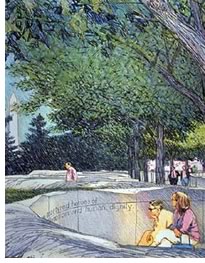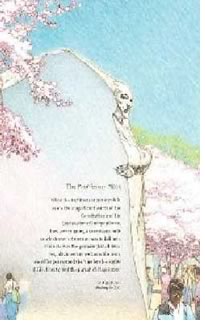

MLK Memorial Evokes Hope and Civil Rights Legacy
Like the ideals that defined his life, the values of justice, democracy, and hope shape the memorial to Dr. Martin Luther King Jr. that will grace the National Mall. United with the site through natural landscape elements—water, stone, and trees—the themes overlap and offer layers of content that await discovery and interpretation by each visitor to the monument envisioned by a joint venture of Devrouax & Purnell, Washington, D.C., and ROMA Design Group, San Francisco.

“All the senses will be engaged through the experience of the memorial, and, foremost, through the visual perception of space, using contrast and juxtaposition, scale and height, and the bold display of carefully selected words expressing his spirit,” noted the design team February 18 at the National Building Museum in Washington, D.C. Ed Jackson, DArch, executive architect for the Washington, D.C., Martin Luther King Jr. National Memorial Project Foundation, introduced the team members: Boris Dramov, FAIA, team leader, and Bonnie Fisher, represented ROMA Design Group; Paul S. Devrouax, FAIA, and Marshall E. Purnell, FAIA, represented Devrouax & Purnell.
 Justice,
democracy, and hope
Justice,
democracy, and hope
The memorial recalls the civil rights activist, educator, and minister
with excerpts of his sermons and public addresses that inspired the movement
toward justice and human rights that is still moving forward today. Jackson,
who is also a research consultant to the AIA, said that ROMA Design Group’s
proposal was selected by an international jury from more than 900 submissions
from 52 countries. Devrouax & Purnell, in addition to developing the
design with ROMA Design Group, will work in Washington to help secure
approval for the design from federal and local agencies and commissions.
The multifaceted memorial will appeal to all of the senses with its diverse, repetitive, and overlapping themes. Water, symbolizing justice, is constant throughout the memorial, with each instance evoking a special interpretation and character. In the original proposal, one source of the water comes from the multiple “martyrs’ wells,” which are individually crafted niches adjacent to the main path. (Because the proposal was submitted in 2000, new security concerns may lead approval organizations to seek other ways to remember these historic figures.)
Each wellspring, hewn from stone, recalls King’s “I Have a Dream” speech at the Lincoln Memorial: “With this faith we will be able to hew out of the mountain of despair a stone of hope.” Individual streams will flow over the wall to form part of a larger torrent cascading down a water wall, where quotes from King’s sermons and speeches are inscribed at a large scale on glistening smooth surfaces. The excerpts will appear chronologically to recount the progression of King’s struggle for equality.
In addition to its symbolic function, water will help cool the environment in the summer months. Textured stone will recall the movement of the falling water in the winter.

Democracy and hope
Fisher said ROMA Design Group’s concept called for a plan that “creates
a space that is truly embracing” and provides a sense of hope. The
design accomplishes that task, she said, through landscaping highlighting
the Tidal Basin’s famed cherry blossom trees that bloom in spring,
the season of King’s April 4 death in 1968. The theme of democracy
also is reinforced by the memorial’s centerpiece, a “Stone
of Hope” that features a 30-foot likeness of King looking across
the Tidal Basin to the Jefferson Memorial, and in the line between the
Jefferson and Lincoln memorials. At the same time, King will hold a pencil
that will point back to his words in “The Promissory Note,”
as if “having just written these words, he is now standing vigil
and awaiting delivery of that note,” the organizers observe.
Fisher points out that the circular design includes a curving stone wall that would have “a very peaceful quality.” It would be contemplative, with a water element, and conveys that “out of a mountain and despair” there can be hope.
 Random
masses of large majestic trees—oaks, pines, magnolias, and cherries—help
usher in the seasons at the memorial and offer opportunities for additional
memorial spaces dedicated to other heroes—such as Rosa Parks and
Fannie Lou Hammer—of the nonviolent struggle for social justice
and change.
Random
masses of large majestic trees—oaks, pines, magnolias, and cherries—help
usher in the seasons at the memorial and offer opportunities for additional
memorial spaces dedicated to other heroes—such as Rosa Parks and
Fannie Lou Hammer—of the nonviolent struggle for social justice
and change.
Fisher noted that city officials are creating a new site that does not exist today by moving one of the main roadways that cuts through the area. This memorial is a reminder, Jackson says, of our role as “active citizens and conscientious stewards” of King’s legacy.
Personal journey
Devrouax, who is in his 31st year of practice with Purnell, said he was
deeply influenced by King’s courage to pursue his dream of a just
nation, and that King’s words inspired him to pursue his dream of
becoming an architect. He and Purnell said it was a privilege to be involved
in the project. “Any architect in America would aspire to it,”
Purnell said and Dramov and Fisher agreed.
King was fatally shot on April 4, 1968. In 1996 President Clinton signed a bill proposing the establishment of a national memorial to King in Washington, D.C. Congress authorized the Alpha Phi Alpha Fraternity, Inc., of which King had been a member, to raise funds from private sources and oversee design and construction of the memorial. The fraternity formed a nonprofit corporation for this purpose, and the federal government donated the site. The fundraising goal is $100 million, of which more than $25 million has been raised. Harry E. Johnson, the president and CEO of the foundation, said they hope to have more than $30 million raised by the ground breaking, which is slated for March.
Copyright 2004 The American Institute of Architects.
All rights reserved. Home Page ![]()
![]()
 |
||
| Get more
information on the Martin Luther King Jr. memorial. All images courtesy Martin Luther King Jr. National Memorial Project Foundation, Inc.
|
||